Stories of SOW
The Stories Behind the First-Ever School on Wheels (SOW) Curriculum
By: Johanna Meier and Emma Warman, 2017-2018 Class SOW Volunteers
***Note: the stories in this article are true and may be disturbing to some readers
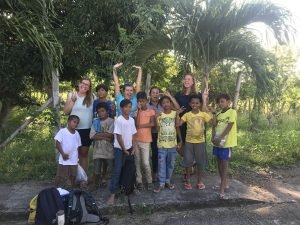 Imagine sitting in the back of a white LCP van, driving through bumpy back roads in dusty Dumaguete. The van stops by the side of a brown, broken concrete-sided river, and the back door bursts open. Whooping, laughing kids pile in, their thin brown bodies barely covered by oversized clothing marked by gaping holes and raggedy edges. It is hard to tell the color that their clothing used to be. The smell is almost unbearable. This is a group of students of the School on Wheels (SOW) Program of LCP, a program that has prepared dozens of past out-of-school children to become enrolled in formal schooling. Children are transported to classes at LCP on weekday afternoons for one year, and those who show the most promise are found sponsors to attend formal school the following year. SOW is known at LCP as the program of the rowdiest and wildest children. Children as young as ten can be found with cigarettes in their pockets, or high on glue or paint thinner, running around LCP with no shoes and urinating on playground equipment. Shocked from this description? You can imagine our feeling when we first started volunteering to tutor and assist in the program.
Imagine sitting in the back of a white LCP van, driving through bumpy back roads in dusty Dumaguete. The van stops by the side of a brown, broken concrete-sided river, and the back door bursts open. Whooping, laughing kids pile in, their thin brown bodies barely covered by oversized clothing marked by gaping holes and raggedy edges. It is hard to tell the color that their clothing used to be. The smell is almost unbearable. This is a group of students of the School on Wheels (SOW) Program of LCP, a program that has prepared dozens of past out-of-school children to become enrolled in formal schooling. Children are transported to classes at LCP on weekday afternoons for one year, and those who show the most promise are found sponsors to attend formal school the following year. SOW is known at LCP as the program of the rowdiest and wildest children. Children as young as ten can be found with cigarettes in their pockets, or high on glue or paint thinner, running around LCP with no shoes and urinating on playground equipment. Shocked from this description? You can imagine our feeling when we first started volunteering to tutor and assist in the program.
Our role as volunteers in the 2017-2018 Class included teaching off-the-bat lessons for the children as the SOW teacher, Carmencita, cooked them lunch. This proved difficult when we had no teaching background or module to follow. Other challenges included unruly behavior of children used to fending for themselves on the street who didn’t take kindly to being reprimanded, as well as vast variations in skill level. Some students had dropped out of school after the fifth grade, while others didn’t even hold a pencil. We did our best to come up with lessons the night before class and to learn words in Bisaya, the local language, to better communicate with students, though we found that accompanying staff on home visits gave us an entirely new outlook on the students in the program.
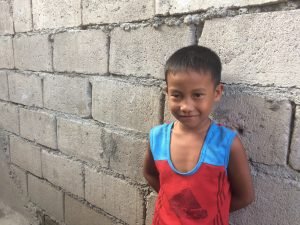 SOW students live along the Banica River in Dumaguete in squatter homes, with large and mostly broken families. Drug use and unemployment run high in this community, and most children, even those few who have a mother or father, are left to fend for themselves. Few, if any, are enrolled in school, due to lack of funds, and apathy of parents. We will share stories from a few children we came to know in the 2017-2018 SOW class. We will change their names in this post to protect their confidentiality.
SOW students live along the Banica River in Dumaguete in squatter homes, with large and mostly broken families. Drug use and unemployment run high in this community, and most children, even those few who have a mother or father, are left to fend for themselves. Few, if any, are enrolled in school, due to lack of funds, and apathy of parents. We will share stories from a few children we came to know in the 2017-2018 SOW class. We will change their names in this post to protect their confidentiality.
We noticed that ten-year old Mark was one of the bullies in class, often causing problems that brought younger students to tears. When we visited his home along the river, we saw it was riddled with bullet holes, and his mother told us about how his father had been killed years earlier by his uncle in a dispute involving drugs. His mother was left to care for Mark and his siblings with no source of income. She tries to scrape together coins from playing bingo, but is unable to make enough to provide for the family or afford school materials for Mark. Once we had seen that Mark’s family situation was a far cry from easy, we had more patience in talking with him when he bullied the other children, and understood more about where his aggression may come from.
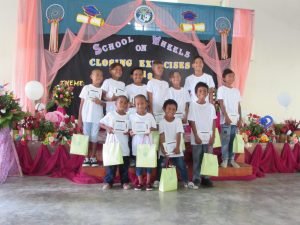 An issue for many students was a sense of motivation about learning or going to school. This was the case for Cynthia, who is thirteen, living in a one room squatter home with four younger siblings, a mother, and stepfather. We learned over time that Cynthia’s mother is a drug user who is unable to care for the children, while the stepfather, working, is also unable to assist in parenting. Cynthia, being the oldest, is expected to look after the others. One week during the SOW year, when her mother was held in a drug rehabilitation clinic in a nearby town, Cynthia brought her siblings with her to SOW during this time so that she could still attend class. She also balanced class with visiting her mother in the rehabilitation clinic to care for her and bring her food and water. A student who we once thought was unmotivated in class we now learned had the drive to multitask and parent at the age of thirteen.
An issue for many students was a sense of motivation about learning or going to school. This was the case for Cynthia, who is thirteen, living in a one room squatter home with four younger siblings, a mother, and stepfather. We learned over time that Cynthia’s mother is a drug user who is unable to care for the children, while the stepfather, working, is also unable to assist in parenting. Cynthia, being the oldest, is expected to look after the others. One week during the SOW year, when her mother was held in a drug rehabilitation clinic in a nearby town, Cynthia brought her siblings with her to SOW during this time so that she could still attend class. She also balanced class with visiting her mother in the rehabilitation clinic to care for her and bring her food and water. A student who we once thought was unmotivated in class we now learned had the drive to multitask and parent at the age of thirteen.
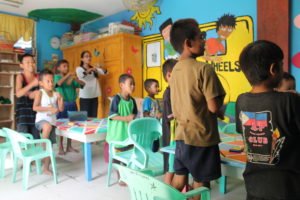 Something else that clear among many SOW children was the experience of abuse in their community. This may have been part of the reason why many children were slow to focus or respond in class. Twelve-year old Christian, for example, grew up with a mother struggling with mental illness, and likely using drugs. His mother seemed unable to stop having children, and after she gave birth to seven, several of the siblings fell in and out of shelters because their parents were unable to care for them. Abuse reported by Christian included an almost daily occurrence of their parents engaging in intercourse in front of the children. When the children would cry and begged their parents to stop, their parents would merely laugh at them and continue. Christian was expected to beg at a nearby convenience store at night, and if he didn’t bring home money, he was beaten. At one point, when he didn’t bring home enough money to please his parents, his eight year old brother began to be sent to beg instead, so he fell out of coming to SOW class for a while. In the middle of the SOW year, Christian was recruited by neighbors to assist in the trafficking of young girls in the community. It took LCP social workers following him at night and begging him to stop to finally bring him to return to class.
Something else that clear among many SOW children was the experience of abuse in their community. This may have been part of the reason why many children were slow to focus or respond in class. Twelve-year old Christian, for example, grew up with a mother struggling with mental illness, and likely using drugs. His mother seemed unable to stop having children, and after she gave birth to seven, several of the siblings fell in and out of shelters because their parents were unable to care for them. Abuse reported by Christian included an almost daily occurrence of their parents engaging in intercourse in front of the children. When the children would cry and begged their parents to stop, their parents would merely laugh at them and continue. Christian was expected to beg at a nearby convenience store at night, and if he didn’t bring home money, he was beaten. At one point, when he didn’t bring home enough money to please his parents, his eight year old brother began to be sent to beg instead, so he fell out of coming to SOW class for a while. In the middle of the SOW year, Christian was recruited by neighbors to assist in the trafficking of young girls in the community. It took LCP social workers following him at night and begging him to stop to finally bring him to return to class.
These stories and countless others helped us to better connect with the children as we spent more time with them throughout the year. The importance of SOW, aside from removing children from dangerous situations and showing them a place where they are loved, is that SOW provides these children a future. For instance, Mark, from the first story, dropped out of school years ago, but after this past year of SOW, he was encouraged and assisted to continue his education. He returned to Grade 4 this past May. Cynthia, in the second story, was enrolled in Grade 5 this past May. Christian, in the third, started in a special education program at a local elementary school in the same month.
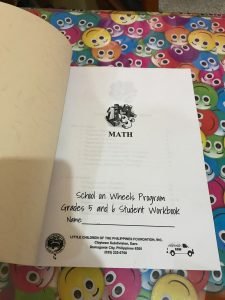 We have come out of one year volunteering in SOW with a different outlook on our own upbringings. We took our nurturing families, our free schooling, and our time to play and be children, for granted. After learning more and more about the situations of the SOW children, we decided to create a curriculum to guide future volunteers to help future students in class. Future volunteers may enter the program with the same prejudices and lack of knowledge that we had, and a curriculum is something we can leave behind to provide lessons and worksheets for volunteers. We worked for several months to compile lessons taken from textbooks and websites for the levels of Preschool, Grades 3-4, and Grades 5-6. Each level has a table of contents marking 50 or more lessons in each topic of Math, Science, and English. There is an accompanying Volunteer Guide to walk volunteers through teaching simple lessons with no prior experience required. We hope that this curriculum, as well as future volunteers and continued funding from donors, will keep the SOW program running to change the lives of children to come.
We have come out of one year volunteering in SOW with a different outlook on our own upbringings. We took our nurturing families, our free schooling, and our time to play and be children, for granted. After learning more and more about the situations of the SOW children, we decided to create a curriculum to guide future volunteers to help future students in class. Future volunteers may enter the program with the same prejudices and lack of knowledge that we had, and a curriculum is something we can leave behind to provide lessons and worksheets for volunteers. We worked for several months to compile lessons taken from textbooks and websites for the levels of Preschool, Grades 3-4, and Grades 5-6. Each level has a table of contents marking 50 or more lessons in each topic of Math, Science, and English. There is an accompanying Volunteer Guide to walk volunteers through teaching simple lessons with no prior experience required. We hope that this curriculum, as well as future volunteers and continued funding from donors, will keep the SOW program running to change the lives of children to come.
Thank you Emma, Johanna, and Feli for your hard work and dedication to creating this curriculum. You are changing the lives of current and future SOW students. Thank you for your time volunteering at LCP and doing such great work.
If you wish to learn more about the School on Wheels programs, read more here.
If you would like to support this program financially, donate here.












